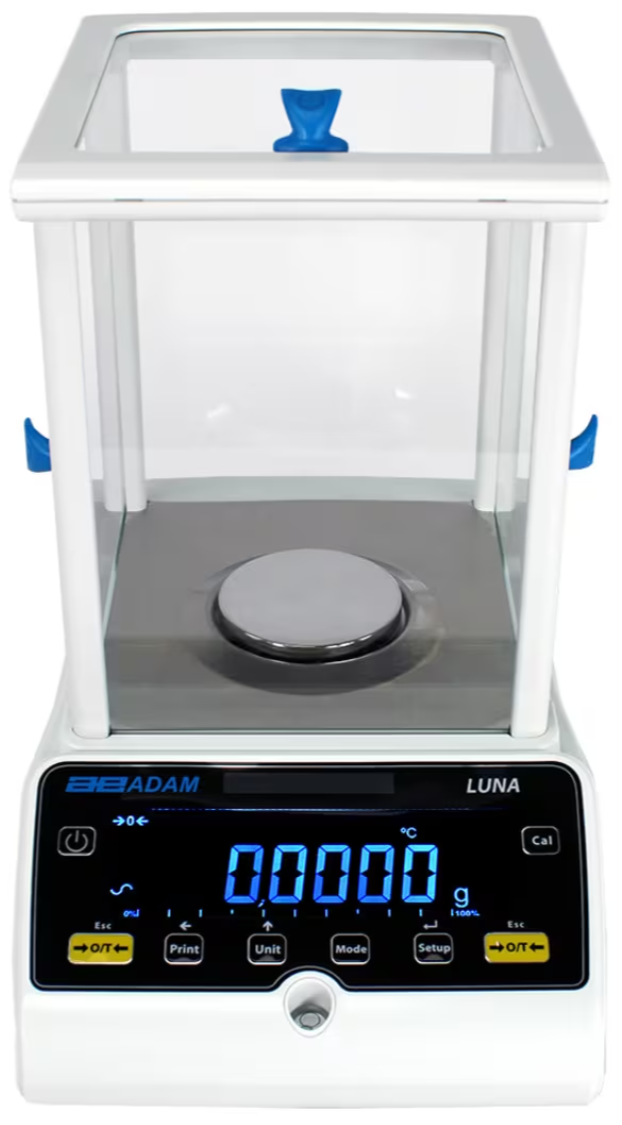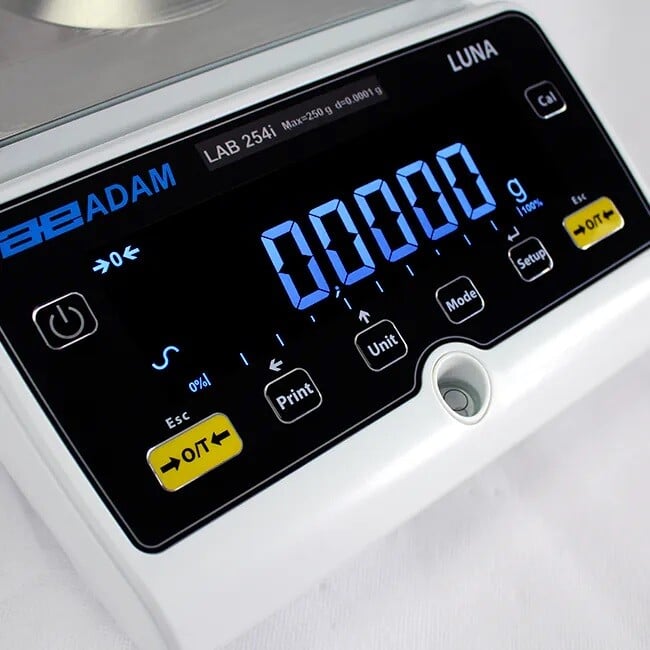Analytical Balances LAB-e
With stylish, modern backlighting, Luna’s impressive display gives an aura of smart sophistication. The LCD features large, readily discernible 24mm digits on a black background. Multilingual text and display capability make Luna well-suited for users in various regions.
Luna provides USB and RS-232 interfaces for speedy data collection and transmission to computers or printers. ABS plastic construction and rugged grade 304 stainless steel pan mean Luna is easy to clean and can withstand demanding lab use.
Available in four models with capacities up to 250g, Luna offers a readability of 0.0001g and can perform basic and detailed measuring tasks.
Overview
Luna Analytical Balances: Precision and Performance in a Stylish Design
Enhanced Performance
The Luna analytical range delivers faster, more accurate readings with a sleek, modern design and backlit display. Models offer capacities from 80g to 250g with resolutions as fine as 0.0001g, meeting the demands of precision applications.
Versatile Weighing Units
Easily toggle between multiple weighing units, including mg, g, ct, oz, ozt, dwt, T, and customizable options to suit a wide range of applications.
Seamless Connectivity
Equipped with USB and RS-232 interfaces, Luna balances ensure efficient data transfer to computers and printers for streamlined workflow.
Clear Display
The large LCD screen features crisp 24mm digits in a blue-on-black layout for easy readability in any lighting conditions.
User-Friendly Navigation
Unique colour-coded keys simplify operation, enabling quick access to frequently used functions for smooth, efficient use.
Optimised Setup
Adjustable levelling feet and a built-in level indicator ensure proper balance alignment for precise results.
Spacious Weighing Chamber
The large weighing chamber with sliding glass doors is easy to clean, offering convenience and preventing contamination.
Reliable Data Tracking
GLP-compliant printouts include date and time, ensuring accurate documentation for laboratory requirements.
Durable Construction
A large, 304-grade stainless steel weighing pan resists wear and simplifies cleaning, while the sealed keypad protects against dirt and spills.
Additional Features
- Vivid backlit LCD ensures visibility in all lighting conditions
- External calibration allows precise verification and adjustments
- Multilingual display for global usability
- Parts counting with preset sample sizes
- Auto power-off function to conserve energy
- Hook for below-balance weighing
- Security slot for optional lock and cable to prevent theft
- Selectable digital filtering for dynamic or animal weighing
- Comes with an AC adapter and a 5-year warranty for lasting performance
Luna Analytical Balances provide accuracy, reliability, and convenience, making them a valuable addition to any laboratory or professional setting.
Specifications
- Dimensions
-
LAB 84e LAB 124e LAB 214e LAB 254e LAB 84i LAB 124i LAB 214i LAB 254i External WxDxH (mm) 224x374x338 - Technical Specifications
-
LAB 84e LAB 124e LAB 214e LAB 254e LAB 84i LAB 124i LAB 214i LAB 254i Capacity 80g 120g 210g 250g 80g 120g 210g 250g Readability 0.0001g 0.0001g 0.0001g 0.0001g 0.0001g 0.0001g 0.0001g 0.0001g Repeatability (S.D.) 0.0001g 0.0001g 0.0001g 0.0001g 0.0001g 0.0001g 0.0001g 0.0001g Linearity (+/-) 0.0002g 0.0002g 0.0002g 0.0003g 0.0002g 0.0002g 0.0002g 0.0003g Minimum Weight
(USP, Typical)0.01g 0.01g 0.01g 0.01g 0.01g 0.01g 0.01g 0.01g Pan Size 80mm ø Weighing Units mg, g, ct, GN, N, dr, oz, ozt, dwt, mm, tl.T, tl.H, tl.S, T, custom unit Stabilisation Time (sec) 2 Interface RS-232 / USB Calibration External calibration Internal automatic calibration / External calibration Display Backlit LCD with 24mm high digits Power Supply 18VDC 50/60Hz 830mA adapter Operating Temperature 15° to 35°C Housing ABS plastic Draught Shield Chamber 192x195x230mm Net Weight 5.8kg 6.2kg
Downloads
Support & FAQs
At Thermoline, we strive to supply helpful customer support to ensure that you get the most out of our products. We are committed to providing whatever support our customers need, wherever they are in the world. If you can't find your solution in the below FAQs or Knowledge Base, please contact our friendly support team.
- What is laboratory balance?
A laboratory balance is a precision instrument used to measure the mass of an object or sample. It is designed for use in laboratory settings and is typically more accurate and precise than a standard scale.
A laboratory balance typically consists of a weighing platform, a load cell to measure the weight of the sample, and a digital display that shows the result. The load cell converts the force of gravity acting on the sample into an electrical signal, which is then displayed on the digital display.
- What is the difference between a scale and a balance?
While scales and balances are both used as weighing devices, their intended purposes vary slightly.
A scale is used to measure weight (weight = the force of gravity on an object on the scale), whereas a balance is used to measure mass. (mass = the amount of matter in an object). A scale is a general-purpose measuring instrument that gives an estimate of the weight of an object. They typically use spring mechanisms to measure weight and have a lower precision compared to laboratory balances.
A balance, on the other hand, is a highly precise instrument used in laboratory settings. Balances use load cells to measure weight and provide a much higher level of accuracy compared to scales. The readout on a balance is usually digital, and the results can be displayed in various units of measurement, including grams, kilograms, and ounces.
- What are the appropriate conditions for a laboratory balance?
- You should first install the balance in a workroom free of vibrations and shakes and where there is no air draft or dust. You want to ensure that the ambient temperature is between +15°C and +35°C while ensuring that the relative humidity is not above 80%. Place the balance either on a robust-design table or on a wall bracket that is both distant from heat sources and insusceptible to vibrations.
- What is the difference between a precision balance and an analytical balance?
Precision balances and analytical balances are both types of laboratory balances, but they differ in their level of precision and the types of applications for which they are used.
A precision balance is a type of laboratory balance that provides accurate measurements within a range of ±0.1 to ±0.01 grams. Precision balances are typically used for routine weighing tasks, such as determining the mass of chemicals for routine laboratory experiments, or for checking the weight of small parts in industrial settings.
An analytical balance, on the other hand, is a highly precise type of laboratory balance that provides accurate measurements within a range of ±0.0001 grams. Analytical balances are used for more demanding applications, such as determining the mass of samples for highly accurate chemical analysis, or for weighing minute quantities of substances in medical and pharmaceutical research.






